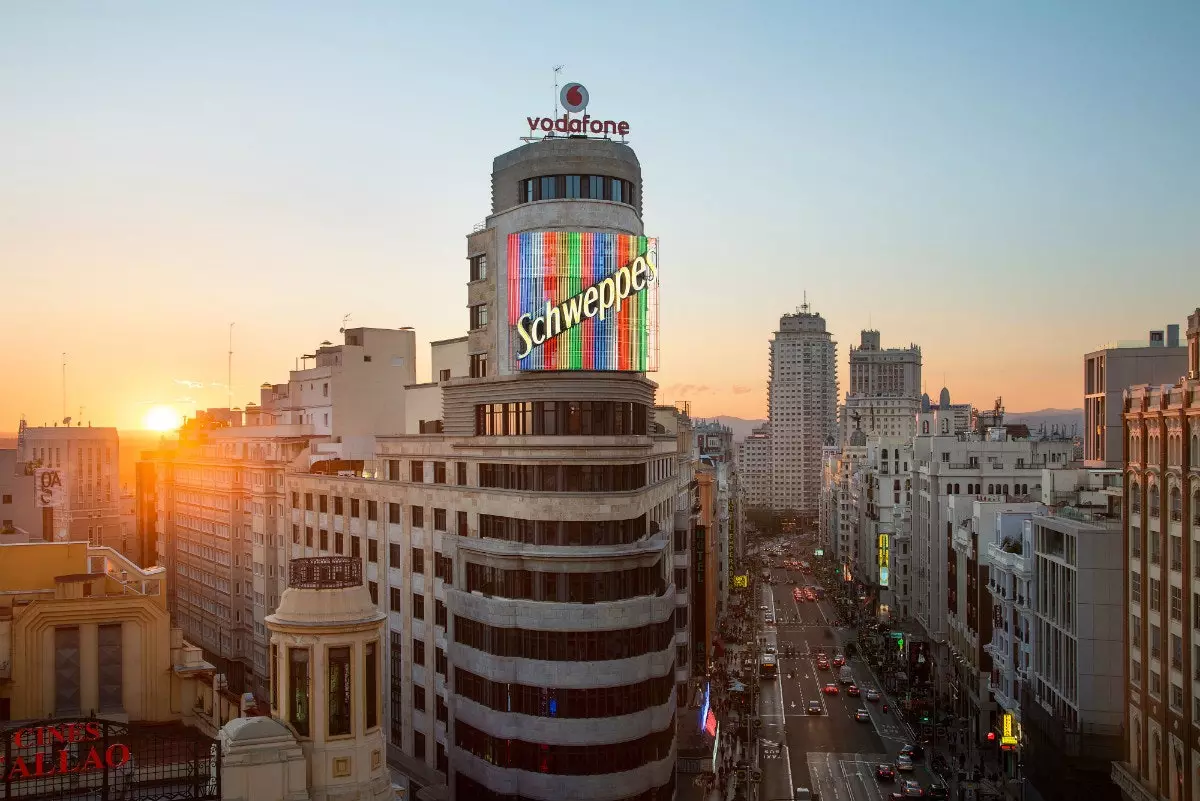
Questions and answers about its ins and outs
WHERE IS IT LOCATED
The Schweppes sign shines on the facade of the slender tower that crowns the Carrión building, in Madrid's Plaza del Callao. Built in the 1930s based on a project by the architects Luis Martínez Feduchi and Vicente Eced Eced, this building currently houses **the facilities of the Hotel Vincci Capitol**, the only one in Spain that has a movie theater, indicate on the Monumenta Madrid website.
“ The Carrión building was designed from the beginning as a place where advertising would be located and, therefore, the placement of posters was a well-known and habitual advertising action. The good location and good visibility in a very busy commercial area made this space a very attractive place for advertising companies”, says Javier Pérez Expósito, professor in the Advertising Communication and Marketing area at Universidad Europea.
SINCE WHEN
Since 1972
WHO HAD THE IDEA?
“It was a decision of the company's marketing team seeing the publicity interest that such an iconic location had in a very important city for Schweppes”, they indicate from Schweppes Suntory.
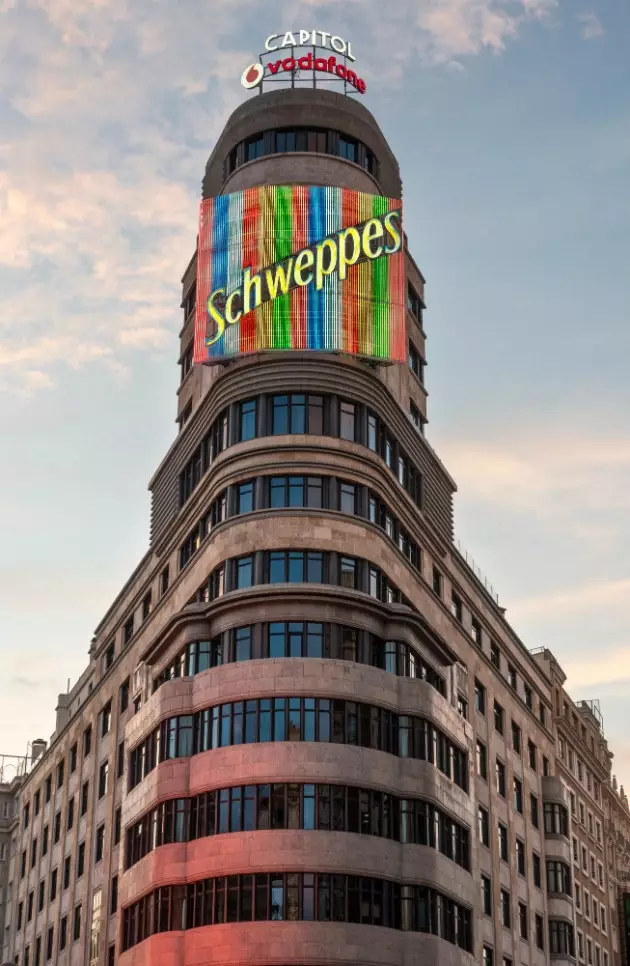
It is located in the tower of the Carrión building
THE LUMINOUS IN FIGURES
It is located 37 meters high, measures 10.65 x 9.36 meters, the letters weigh 100 kilos and the 600 sign assembly. It is made up of 104 neons.
SWITCH ON SCHEDULE
AND he neon works from 05:00 a.m. to 08:00 a.m. and from 05:00 p.m. to 02:00 a.m. during the winter months (between November 1 and March 31) . During the summer (from April 1 to October 31), from****06H00 to 08H00 and between 9:00 p.m. and 2:00 a.m..
HOW DOES IT WORK?
The neon lights turn on and off thanks to a computer system consisting of different phases : at night it has a cycle in which the Schweppes brand starts to light up little by little in blue and then in yellow. When this part ends, the colored neon lights up from right to left and goes out from left to right twice each step. Later, the neon is turned on from the outside in and off from the inside out three times each. Then, neon color by color, each one turns on and off (one yes, one no) five times. The cycle ends with all the neon lighting up and the yellow Schweppes brand flashing three times. , they explain from the company.
COLORS
Blue and yellow for the letters. Pink, different shades of blue, red, yellow and green for the rest of the sign.
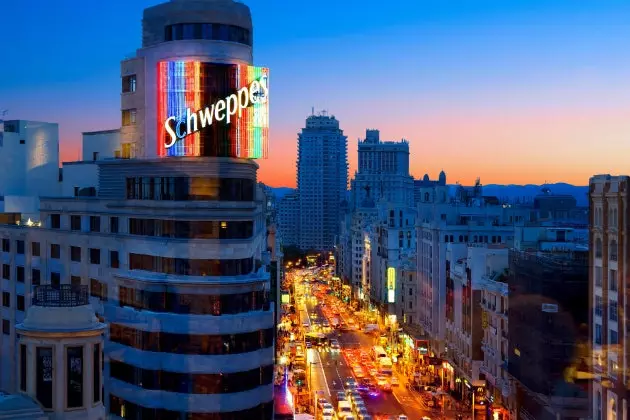
A computer system marks its operation
WAS IT THE FIRST LUMINOUS ADVERTISEMENT IN MADRID?
"Not really. In fact, there was even a previous one from the same advertiser that was located very close, specifically on Calle San Bernardo and that represented a bottle of Schweppes in effervescence. Unfortunately it no longer exists. Nevertheless, the best known case is that of the manzanilla Tío Pepe light in Puerta del Sol, which was placed in 1935 and that it has even withstood the bombings of the Civil War”, explains Pérez Expósito.
WHAT ABOUT THE CARRION BUILDING?
Either. “Before the Schweppes light was installed, there was a poster of the Camel tobacco brand in the same place ”, specifies Pérez Expósito.
HAS IT ALWAYS BEEN PRESENT ON THE FACADE?
Yes, except for 10 weeks in 2004 when it was withdrawn to undertake remodeling work.
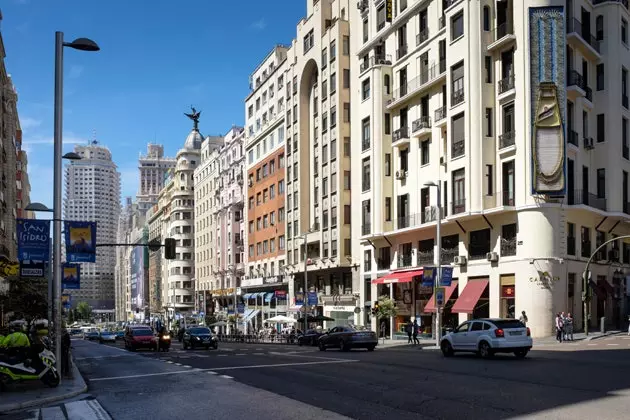
The missing Schweppes bottle
REMODELING
Some 32 years after its placement, in 2004, the uppercase letters of the brand were changed to lowercase and the light was completely restored to renovate the installation and eliminate the traces of contamination that covered it.
WHAT DOES YOUR MAINTENANCE CONSIST OF?
Annual reviews of the structure and its components are carried out . The usual incidents are the renewal of neon tubes and the replacement of transformers , indicate from Schweppes Suntory.
WHAT IS HIDING BEHIND?
As is logical since it is a hotel, behind the sign we find rooms. Specifically, **the 1102 and the 1002, known as the Vincci Skylight **. These are two suites with a semicircular shape and a decoration that honors the popular tonic brand. Namely, a round bed alluding to the bottle cap yellow furniture and a bubble patterned carpet.
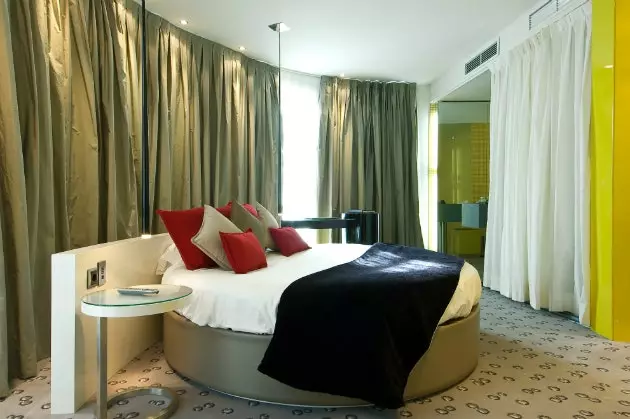
In this room everything revolves around the brand of tonic
Located on the 10th and 11th floors of the building, these rooms they did not open to the public until 2007 , year in which the hotel facilities were remodeled. Previously, that part of the establishment was unused as it was considered that no one would want to sleep behind a neon sign. However, with the improvement work they decided to turn what was supposed to be a handicap into an attraction that they give to those who stay in them. the possibility of contemplating the Gran Vía covered by a veil of changing and intermittent color.
Staying in one of these suites is possible from 125 or 140 euros per night , when there is not much occupation, although the final price fluctuates depending on the demand and the days. Among its clients, profiles of the most varied. From fans of the movie The Day of the Beast, to photography lovers who want to capture the perfect snapshot, through those who want to treat themselves to a special night and, of course, foreign tourists who are unaware of the fame of neon. In fact, those responsible for the hotel say that one of them called reception at night to ask what time the sign would go out, not because he bothered her but because he wanted it to stay that way all night.
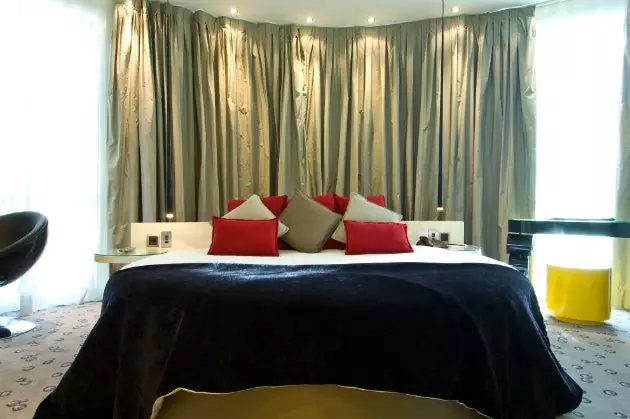
Sleep in a sanctuary of the tonic
WAS IT A MILESTONE IN THE ADVERTISING WORLD?
The Schweppes luminous along with other similar cases "these are important elements that mark the evolution of advertising in Spain . Not so much because of their effectiveness or their creativity, but because they generate the values that modern advertising communication is beginning to put in its true place (...) It is a clear example of transmission of intangible values of the brand , have become symbols that have transcended the commercial and cultural elements, identifiers and differentiators, with a social function. Not only do they not pollute, but they integrate and give added value to the landscape where they are located”, explains Pérez Exposito.
WHY HAS IT BECOME AN ICON?
Although it was not the first or the most creative, “it is true that it is perhaps the most emblematic of illuminated signs and the most recognizable. Either because of its cultural significance or because of the coincidence of its location with the culture of the 70s, the birth of urban culture in Madrid or its appearance in all kinds of cultural events that have subsequently made it an icon” , reflects Pérez Expósito. And it is that his appearance in scenes and images of films, series, paintings or photographs of Madrid they have turned it into an element that is as recognizable as it is indispensable for the city and its inhabitants. "Perhaps the most popular was the scene from the film El Día de la Bestia, by Álex de la Iglesia, but it has also appeared in innumerable artistic works of all kinds," he adds.
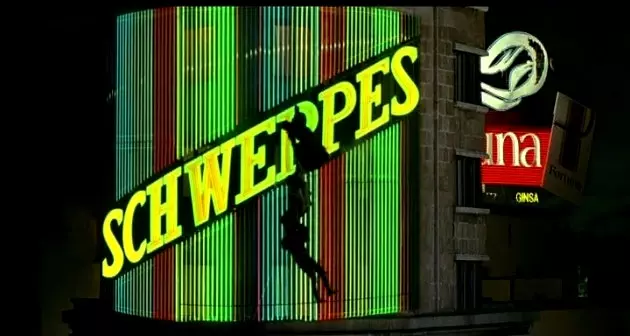
This scene placed the sign in our collective imagination
**THE DAY OF THE BEAST (1995) **
We have postponed it as long as possible so as not to repeat ourselves, but one cannot speak of Schweppes' light and not refer to the film that definitively installed it in our collective imagination. In 1995 he starred in one of the most legendary scenes in Spanish cinema, when the protagonists of El Día de la Bestia climb up his letters. A curiosity? Father Ángel, José María and Professor Cavan did not stray from the original, but of an exact replica reproduced for the recording of the scene in the studio for security reasons.
HAS YOU EVER ENDANGERED YOUR EXISTENCE from him?
“In 2009 and when Alberto Ruiz Gallardón was mayor of Madrid, an ordinance was passed regulating outdoor advertising in the city [prohibited illuminated signs in the center of the city]. As a result of years of little control and regulation of the sector, there were billboards and lights that 'polluted' not only light but also the landscape of the capital. However, from the beginning it was believed that several of them, including the Schweppes cartel, should be considered as cultural property and therefore were pardoned and thus ensured their continuity ”, explains the professor at the European University. In fact, It was in 2010 when the City Council awarded the light the category of Historic Label after the request for pardon by the company, they explain from the Consistory.
DO WE HAVE NEON FOR A WHILE?
Of course! From the company they point out that "Madrid's Gran Vía would not be the same without the Schweppes light, so we can continue enjoying its colorful light for many years ”.
Follow @mariasanzv
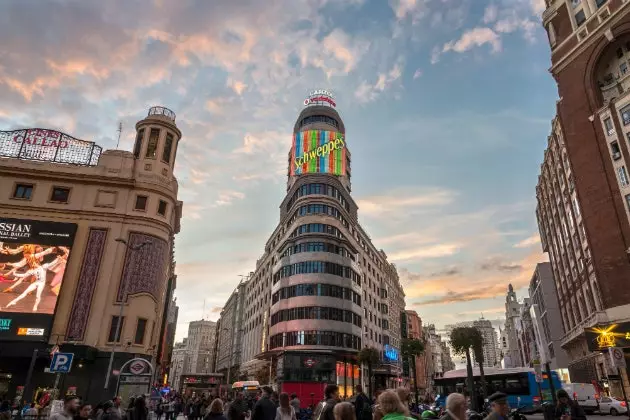
Calm down, we have neon for a while
